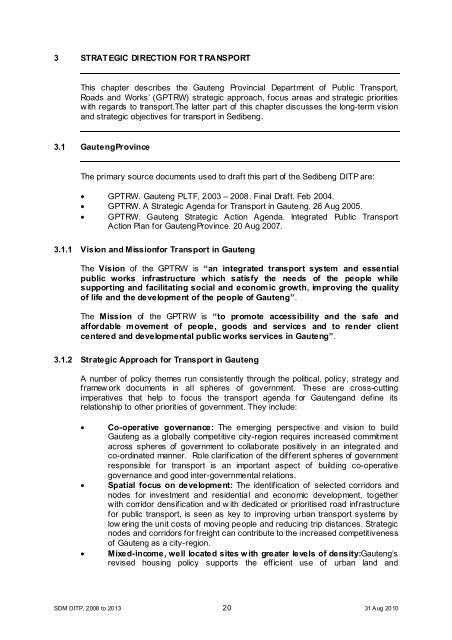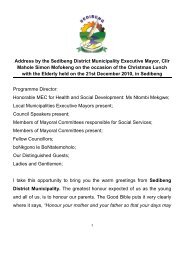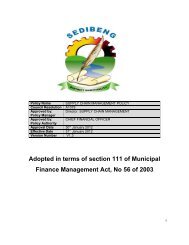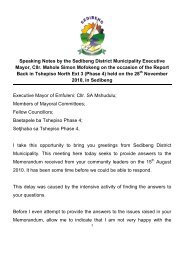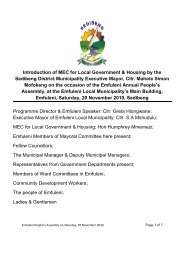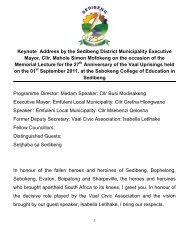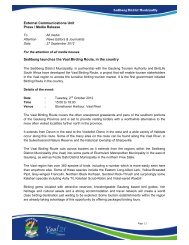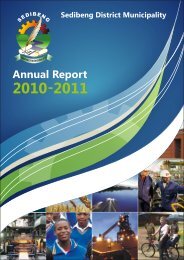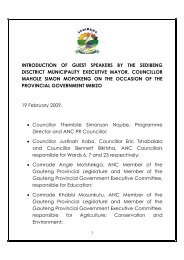Chapter 11 - Sedibeng District Municipality
Chapter 11 - Sedibeng District Municipality
Chapter 11 - Sedibeng District Municipality
Create successful ePaper yourself
Turn your PDF publications into a flip-book with our unique Google optimized e-Paper software.
3 STRATEGIC DIRECTION FOR TRANSPORT<br />
This chapter describes the Gauteng Provincial Department of Public Transport,<br />
Roads and Works’ (GPTRW) strategic approach, focus areas and strategic priorities<br />
with regards to transport.The latter part of this chapter discusses the long-term vision<br />
and strategic objectives for transport in <strong>Sedibeng</strong>.<br />
3.1 GautengProvince<br />
The primary source documents used to draft this part of the <strong>Sedibeng</strong> DITP are:<br />
• GPTRW. Gauteng PLTF, 2003 – 2008. Final Draft. Feb 2004.<br />
• GPTRW. A Strategic Agenda for Transport in Gauteng. 26 Aug 2005.<br />
• GPTRW. Gauteng Strategic Action Agenda. Integrated Public Transport<br />
Action Plan for GautengProvince. 20 Aug 2007.<br />
3.1.1 Vision and Missionfor Transport in Gauteng<br />
The Vision of the GPTRW is “an integrated transport system and essential<br />
public works infrastructure which satisfy the needs of the people while<br />
supporting and facilitating social and economic growth, improving the quality<br />
of life and the development of the people of Gauteng”.<br />
The Mission of the GPTRW is “to promote accessibility and the safe and<br />
affordable movement of people, goods and services and to render client<br />
centered and developmental public works services in Gauteng”.<br />
3.1.2 Strategic Approach for Transport in Gauteng<br />
A number of policy themes run consistently through the political, policy, strategy and<br />
framew ork documents in all spheres of government. These are cross-cutting<br />
imperatives that help to focus the transport agenda for Gautengand define its<br />
relationship to other priorities of government. They include:<br />
• Co-operative governance: The emerging perspective and vision to build<br />
Gauteng as a globally competitive city-region requires increased commitment<br />
across spheres of government to collaborate positively in an integrated and<br />
co-ordinated manner. Role clarification of the different spheres of government<br />
responsible for transport is an important aspect of building co-operative<br />
governance and good inter-governmental relations.<br />
• Spatial focus on development: The identification of selected corridors and<br />
nodes for investment and residential and economic development, together<br />
with corridor densification and w ith dedicated or prioritised road infrastructure<br />
for public transport, is seen as key to improving urban transport systems by<br />
low ering the unit costs of moving people and reducing trip distances. Strategic<br />
nodes and corridors for freight can contribute to the increased competitiveness<br />
of Gauteng as a city-region.<br />
• Mixed-income, well located sites w ith greater levels of density:Gauteng’s<br />
revised housing policy supports the efficient use of urban land and<br />
SDM DITP, 2008 to 2013 20 31 Aug 2010


